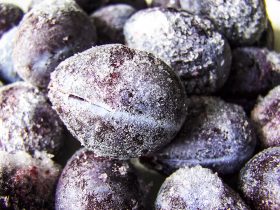Grapefruit are a descendent of a cross-species union between oranges and the pomelo fruit. With a lineage that can be traced back to the Caribbean islands, grapefruit soon became incredibly popular throughout much of the western world.
With an orange-red outer skin and flesh-colored inner meat, grapefruit has a distinctly sweet and sour taste that is often added to complement many dishes and drinks, such as cocktails or fruit salads.
Like all kinds of fruits and vegetables, grapefruit requires protection and insulation from the hazardous effects of the environment as well as from opportunistic life forms like insects, bacteria and fungi. The ideal way to pull this off is by freezing the grapefruit, though this will take several steps and precautions to perform properly1.
What is the Ideal Temperature for Storing Grapefruit?
The vast majority of organic produce requires the temperatures in which they are stored to be both stable and at the appropriate level so as to prevent a loss of quality.
This is highly variable between the type of produce you are choosing to store, and as such it is vitally important to tailor your storage conditions for the particular vegetable or fruit you are preserving.

In the case of grapefruits, high temperatures will activate and accelerate the fruits’ own enzymes, causing it to spoil from within at a faster pace than it would at lower temperatures.
High temperatures also have the effect of encouraging microbial growth, which will not only make the grapefruit harmful to eat but also release spores into the air, potentially spreading to other produce in the area.
In a publicly released dump of information, the University of Maine has stated that the ideal temperature for storing grapefruits is at or slightly below 40°F2, or the average minimum temperature of most commercially available refrigerator devices.
What is the Ideal Humidity for Storing Grapefruit?
While temperature is one such factor that causes rapid spoilage of your grapefruit if not kept in the proper parameters, humidity is also equally important in the pursuit of preserving most fruits and vegetables.
Much like the effects of temperature, humidity will also encourage any enzymes within the grapefruit to begin breaking it down at a chemical level, causing it to grow infirm to the touch and to lose its signature flavor.
Apart from enzymatic action, improper storage in a low humidity environment will cause the air to leach out any water within the grapefruit via osmosis and evaporation, thus essentially dehydrating the fruit.
Another factor to consider when controlling the humidity of a storage area is that most forms of bacteria and fungi need a readily available source of water in order to propagate properly. Even the water content within the air itself is sufficient to provide for the needs of these microorganisms. It is because of this that controlling humidity within your storage area is extremely important.
In a tangentially related study to the previous one conducted by the University of Maine, the proper humidity that grapefruit must be stored at is a relative ninety-five percent, quite a bit higher than most cupboards or kitchen countertops3.
Should You Cut Grapefruit Prior to Freezing?
Yes, it is our recommendation that you first cut your grapefruits into less cumbersome pieces prior to freezing them as grapefruits can grow to be quite large and may be difficult to store in the freezer, all the more so because of their circular shape.
While grapefruit will last longer with their peel kept intact, the benefits to cutting it far outweigh the drawbacks so long as you are choosing to freeze the grapefruit. It is best to leave the grapefruit uncut if you are choosing to store it in the pantry or even the refrigerator.
Can You Freeze Dried Grapefruit?
Though dried fruit has a far longer shelf-life than its hydrated counterpart, it is still perfectly capable of going bad when it is stored in high-humidity environments or if otherwise exposed to bacterial and fungal colonies.
Grapefruit in particular, while uncommonly found in its dried form, still requires itself to be sealed away from the air in order to maintain its relative freshness for a longer period.
In short – yes, dried grapefruit can be frozen, so long as it is carefully sealed within an air-tight container or bag free of any moisture. Ideally, one would vacuum-seal the dried fruit in plastic before storing in the darkest section of your freezer.
How to Freeze Grapefruit
In the process of freezing your grapefruit, it is advisable to keep in mind the fact that no organic produce will truly preserve the entirety of its quality at temperatures below 32°F, as this will cause water to expand and crystallize within the produces’ cells, affecting their structure at a microscopic level.
While the particular extent of the damage to the produces’ quality depends entirely on what it is that you are freezing, grapefruit specifically suffers from freezing in a dramatic fashion. Not only will the inner flesh of the fruit experience discoloration, but it will also develop a softer, more slimy texture.
This is not to say that the grapefruit will become entirely inedible, however, and if your plans for the grapefruit involve activities such as using it for shakes or ice cream, then freezing it is an excellent form of storage.
Before starting, you will need to gather together a sufficiently large enough knife, a parchment or wax-paper lined baking tray as well as several resealable plastic pouches or freezer bags.
To begin, wash the surface of the grapefruit, removing any stickers or dirt that it may have accumulated during its time at the market. After washing, dry the peel with a cloth towel.
Cut the grapefruit into your desired serving shape, such as wedges or in discs and place these individual slices along the lined baking tray. Space them apart from each other at a sufficient distance so they do not freeze together.
Place the tray of grapefruit slices in the freezer uncovered for two hours, preferably far away from any rapidly moving sources of air such as a vent or freezer fan, as these will cause freezer burn.
After two hours have passed, simply retrieve your grapefruit slices and pile them into your resealable plastic pouch or freezer bag. Leave in the freezer for up to a month, though degradation of the grapefruits’ quality will occur sooner than this time.
References
1. Unknown Author. (January 2019) “Grapefruit, raw, pink and red, all areas” U.S. Department of Agriculture
2. Karen L. B. Gast. (N.D.) “Bulletin #4135, Storage Conditions: Fruits and Vegetables” The University of Maine
3. Hardenburg, R.E., A.E. Watada and C.Y. Wang. 1986. The Commercial Storage of Fruits, Vegetables, and Florist and Nursery Stocks. USDA-ARS Agriculture Handbook Number 66 (revised) 136p.





Hi, I'm Dom
Dom Eats was started to help other people fall in love with food. While cooking can feel intimidating, it doesn't have to be.